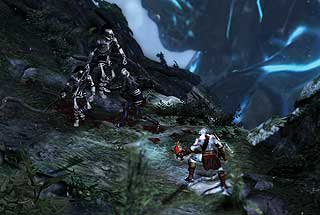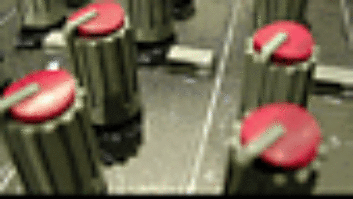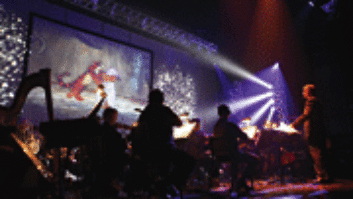
Game Still Courtesy of Sony Computer Entertainment
It’s been five years since the first God of War videogame came out on the Sony PlayStation 2 platform and became an instant sensation among serious gamers worldwide. Combining a richly detailed story using numerous characters and settings from Greek mythology with fast-paced and gory action and sophisticated gameplay, the title won a slew of awards and, not surprisingly, has spawned a franchise that includes God of War II (2007), God of War: Betrayal (2007; a spinoff for mobile devices), God of War: Chains of Olympus (2008; a prequel to the series developed for the PlayStation Portable) and now, on a wave of anticipation and hype, God of War III (GOW3) for the PlayStation 3.
More than two years in the making, GOW3 ratchets up the action to new extremes as we follow the further adventures of Kratos, a mighty Spartan warrior who battles various gods and titans, and is, as we learned in GOW2, the son of Zeus, who has tried to kill him and vice versa over the course of the GOW adventures. Along the way, he encounters a plethora of mythological characters and creatures, including Athena, Gaia, Kronos, Pegasus, Perseus, Atlas, Ares, the hydra, the harpies and all sorts of bad dudes and beasties who make life rather challenging for our tormented hero. The range of characters and plot points in GOW3 was a still closely guarded secret when I was preparing this story in early February, but from looking at the previews and an online demo of the game, it appears there is plenty of bloody mayhem involving everything from skeleton warriors to a fire-hurling god to frightening flying creatures, centaurs and you-name-it. In what director Stig Asmussen claims will be the last adventure in the series, Kratos’ goal is no less than the destruction of the home of the gods, Mount Olympus!
As you might expect, the sound team on GOW3 really had their hands full. Between the staggering array of battle weaponry (much of it with enhanced, nearly supernatural qualities, like the Blades of Athena that Kratos wields against his foes and, new for this game, the giant over-fist battering gauntlets known as the Cestus), the fires, explosions, creatures/monsters and ambiences required, there was an amazingly detailed sonic world to create. As was the case with the first two PlayStation 2 GOW games, the bulk of GOW3‘s sound and visuals were done at Sony Computer Entertainment of America’s Santa Monica Studios (Santa Monica, Calif.) game-production facility. And because the game was developed for PS3, the sound team was able to create an even more sophisticated and highly detailed soundtrack.
“The fact that God of War III is on the PS3 as opposed to the PS2 is huge for sound,” comments lead sound designer Paul Fox. “We don’t have the 2-megabyte limit we used to have on PS2, which definitely affected overall audio fidelity. On any PS2 game, you had to make some sacrifices to get things to fit into memory. It still sounded good, but these days we’re able to set higher standards with the PS3. Now with the PS3, we’re at what I would consider modern-quality sound — we can pretty much always do stuff at the highest quality. But the other thing about moving to the PS3 is that the actual amount of work to get the sound job done is exponentially larger now. The games have more content in them and more detail that we cover with sound than we were able to do before.” Indeed, GOW3 contains an estimated 10,000 sound IDs (encompassing FX, music and dialog), “an order of magnitude more than the previous PS2 GOW game,” Fox says.
According to sound designer Steve Johnson, the expanded sonic capabilities of the PS3 allows the designers and implementers to integrate different sorts of sound sources in a way that is nearly seamless for the player — in the same way that animation of the game play is now almost on a par with the cinematics. For instance, he notes, “Because we know Kratos does this, then this and then this in a scene, we’re exploring the opportunities of more linear-style sound at key points, sending whole premixed sections of sound directly to chosen speakers in a single file. I think one of the real technical achievements of this game is that we have up to as many as 20 pre-buffered streams at any one time — sound that’s streaming off of Blu-ray, not in RAM. Traditionally. that’s reserved for music, ambience, cinematics. Now, let’s say there’s a mini-game in a scene that might have four onscreen prompts in which you have to time your button-presses perfectly to make sure you actually kill, etc. We’re doing things where we might have, say, a 5.1 stream prebuffered up to the first button-press; we know there are two button-presses that follow in succession that might last two or three seconds each — we can cover those sections in stereo and RAM — and then, say, have the fourth button-press cause a second surround stream to come in for the final kill animation. We’re able to script it so that playing the first stream triggers the pre-buffering of the second stream. And we know that once the second happens, there’s no turning back, so we tell it to drop the first. So we’re juggling traditional game sound with a lot of more linear post work.”

The God of War III sound team, from left: sound designer Steve Johnson, sound design manager Phillip Kovats, lead sound designer Paul M. Fox and Gene Semel, senior manager, sound group
Photo: Barbara House
Adds sound design manager Phillip Kovats, “What we’re trying to achieve with what Steve is talking about is a sort of heightened cinematic adventure experience for the players that they really were not able to access with the older God of War games. With the PS3, we can really hit it hard. And with the advent of other more cinematic games, like Asssassin’s Creed 2 and Uncharted 2, the ante keeps going up.”
Some of the sounds in GOW3 were carried over from the previous games, but where possible they’ve been upgraded to take advantage of the increased sample rate. Mostly, though, the soundtrack was freshly created from a combination of new FX recordings, Foley and sometimes combining those elements with library material and altered in new ways. “One of the things we were able to do with both the quality of sound and the quantity of sound is really detail out Kratos’ movement Foley,” Kovats comments. “We did a lot more armor work on him and changed his footseps up and added a lot more chains and other touches. We worked closely with [Foley artist] Gary Hecker at Todd-AO to bring this role alive in a different way, to make it more fun for the player.”
Kovats also notes that David Farmer, who worked on GOW2 and the GOW PSP game (Chains of Olympus) “came back to help sculpt a lot of the new creature sounds for the game, and we even had him go back and revisit some of the ones we had done for PS2; because we had more memory and variety, we could add to this game. He helped us out a lot on the vocals and attacks of these creatures.”
As is usually the case with videogames, the early stages of sound design were done to sketches and crude animations, which necessarily change over time as work on the game progresses. As Steve Johnson explains, “A lot of times it comes down to loading the guns, as I’ve heard it called. You know a certain creature is going to need to be covered. You know that animations are probably going to change, timings will totally change, so a lot of times it’s pulling together these assets into Pro Tools sessions and then sorting through it all when the time comes. You know there are going to be these titans over several areas of the game, and one titan may be made of a certain material than a different one, so you start pulling this all together, and these Pro Tools sessions start getting huge-er and huge-er, and then toward the end of the project, things start getting locked down and then it’s all-hands on deck — we’ve gotta get this done — and hopefully it’s all there and ready to go, and you’ve identified the characteristics of certain areas of the game and of certain characters.”
“Animations are the bane of every sound designer’s world when it comes to in-game sound design because animations change all the time,” adds senior manager, sound group, Gene Semel. “We try to work in parallel development [with the animators] as much as possible, so whenever an animation is coming online, we’re trying to put sound to those animations so that every time the game is being played during the process of development, there’s as much sound in the game as possible to give us a clear picture of the overall scope and idea of what the game is going to sound like.
“It’s similar to in film where guys are seeing wire frames in their sound design on the rough cuts and they don’t start seeing the final visual effects until really close to the end of the project. It’s the same with games. That’s one of the differences between previous console developments to what we’re dealing with now because there’s so much more content, so much more everything — art, animation, physics — going into it, and it all seems to waterfall at the very end of a project. We’re talking thousands and thousands of changes in the animations, so you can imagine how much work that is for us on the sound side, too.”
One of the challenges of this particular game, Kovats says, was conveying the sense of scale — the way the action might shift from a scene where Kratos is battling a small winged creature, to one where he is in the frame with and/or fighting with one of the enormous titans. Every aspect of the game presents a different mixing challenge, it seems, so it’s no surprise to learn that — as with feature film mixes — doing a game mix can be an extremely long and involved process. GOW3 was mixed at SCEA’s Santa Monica Studios “with a keyboard and mouse,” Paul Fox says, rather than using a giant post-production console as usually happens with Hollywood films.
“We were very keen on trying to run it on a schedule where we had a full week to play through the game and mix,” Fox continues. “In our software sound system, we have 31 mix channels that we can assign sound IDs to. So we have the usual three suspects at the top: Sound effects, dialog and music each have a main ‘fader’ they’re on, and then we have a bunch of other faders available for special cases and for breaking things down into smaller bits. So we’ll have a Foley channel, we’ll have a channel for impacts, a channel for creature vocals — as opposed to humanoid vocals — and a couple of other special cases; for instance, if we need to sidechain one thing to be ducked by another thing. We also have a dedicated channel for the soundtracks that play under the cinematics.”
“Our mixer is snapshot-based, and using those 31 channels we can have a lot of great submixes to get a lot of detail in and out of the game for certain times,” Kovats adds. “Like you might be going through this crazy fight where you really want to hear the creature vocals and the weapons; then you might go into an intimate scene and we’ll bring the ambience and the music down a little bit and the dialog up because you really want to hear the detail in the story. We have a great tools and tech department up in Foster City [Calif.] and they’ve helped develop a lot of great tools, which is just short of having a mix board in front of us to create these really great snapshot mixes. We also use proprietary DSP technology on the output of the game to make sure we have limiting and compression on the dialog and other things.”
Fox notes, “We are also very lucky that our director is interested in and cares a lot about sound and that he wanted to sit with us and do play-throughs before our mix. We kind of had a premix, believe it or not, and that’s never happened in a game I’ve worked on, though I’ve always thought it should. It was a great opportunity because he was able to listen to the game with us — just the sound team and the director — so we were able to make doubly sure we were getting things covered that were important to him. Having Stig with us listening to stuff, we could address some very important continuity-related and gameplay-relevant sound design opportunities that might not have been as easy to spot on our own given the tight schedule.”
Among the other issues that crop up at the mix stage are keeping sounds in proper perspective as Kratos moves through the environment; bringing distant sounds closer as the action moves toward what was once the far background; adjusting sounds in the immediate foreground as sound emitters are reached and then passed; retaining the ambient sound of the environment but allowing the action in the foreground to supercede other sound sources; giving spatial dimension to the scene while also letting the music track add more emotional depth to the scene; and making sure that dialog can be heard at all times. It’s a long and involved process that requires the sound team to play the game over and over again to attain the greatest clarity, variety and power possible.
I ask whether the sound designers and implementers regularly check their work on the sorts of small computer speakers that most gamers still play on. “Yes, that’s very important to us,” Fox replies. “We listen to it coming out of our TV speakers, too. We also get a lot of feedback from team members because during the last weeks of the game [production], a lot of people are getting locked out from making changes to the level design and visuals, so those guys are sitting playing through the game, wearing headphones or listening over TV speakers. It’s a real team effort.”
The last weeks of game production are invariably long and intense as the final visual elements come in and the audio team makes its last adjustments to match the changes. It requires tremendous cooperation between departments and strong guiding hands to keep the work moving forward coherently and in a timely fashion. Semel says, “We know we’re going to have a [work] spike at the end — it’s the way games go. We would love to have a month at the end to finesse things after they’re locked down, but at this point that’s still a dream. Game development is always to some degree organic because you plan for things, you have your milestones, but you also have to be flexible and open to trying things along the way because finding the fun is a big factor in making games. You do whatever you can to make a game that people will enjoy playing.
“We’re preaching to the choir here, I guess, but obviously we all believe that sound is a big part of the [game-playing] experience. Sound adds so much to the visceral feeling you get playing a game. And, of course, game scores [in game magazine reviews] now often grade for sound, as well as graphics and game-play, and those scores do affect sales, so sound is important on that level, too.”
“As has been the case for years and years, when we really do our job well, it’s not usually noticed,” Paul Fox concludes. “When things sound as they should and as expected, our hard work isn’t obvious. So we like to do over-the-top interesting sound design when we have the opportunity — and there were a lot of places in this game where we could do that. Honestly, though, I think some people still don’t understand that there was nobody on set with a boom mic [laughs], that literally everything in that game went in there from scratch.”
Blair Jackson is the senior editor of Mix.






